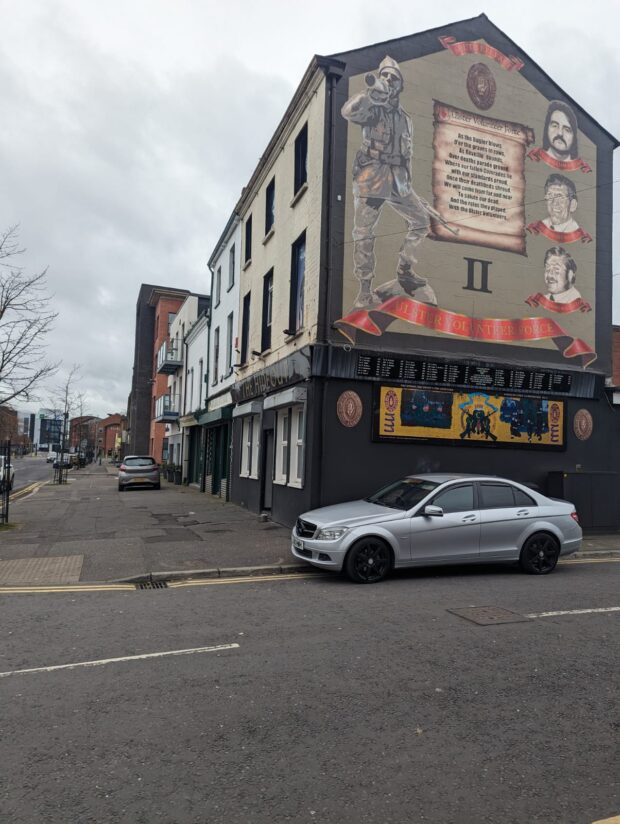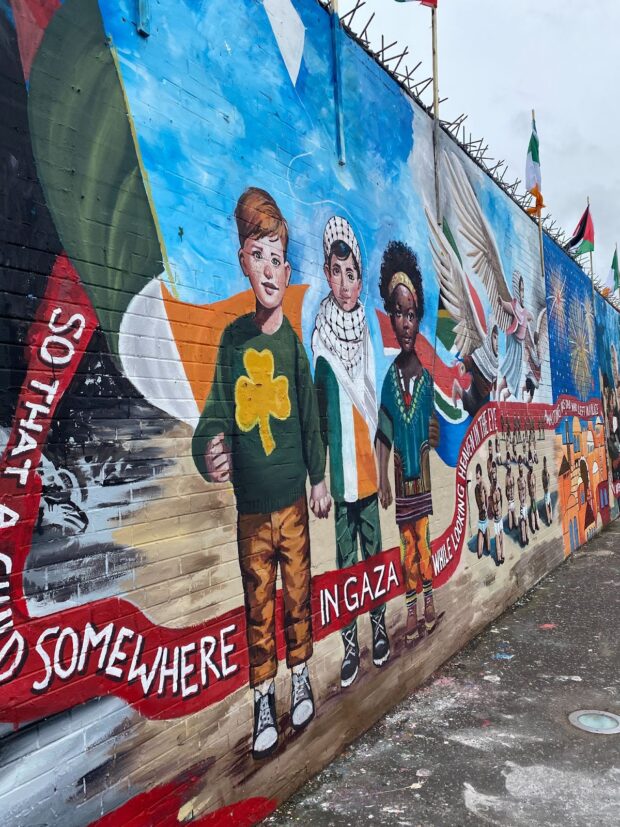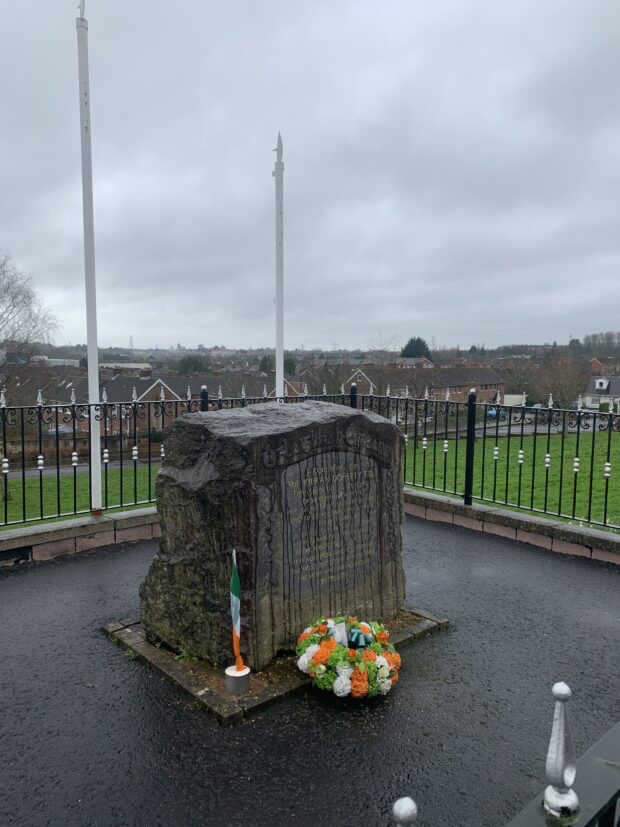
BELFAST – The last day of our trip through Ireland started again with a traditional Irish breakfast in the Europa Hotel. The rainy, gray morning skies of Belfast contrasted the occasional green on the streets: a reminder that it was the eve of St. Patrick’s Day. Our class departed each our own way as our day was dedicated to individual reporting and some sightseeing.
Dina Katgara went to Best of 3, a live comedy show at the Black Box in Belfast, to report on comedians who weave the aftermath of the Troubles into comedy. It gave her a thought-provoking perspective into how people in Northern Ireland cope with stereotypes about religion, as well as trauma. There were some dark jokes that we have come to expect from Irish humor. One of the comedians held up his favorite toilet paper brand, Regina Blitz, and made a joke about cleaning up the blood from Bloody Sunday with it.
Renata Carlos Daou interviewed an asylum seeker from Iraq who works as a photojournalist in Belfast. They talked about his experience as a Muslim and immigrant in a country that still predominantly consists of both Catholics and Protestants.
Natalie Demaree and Genevieve Charles spent the day reporting in County Down at a St. Patrick’s Day Prayer pilgrimage. More than 150 people from all over the world attended the rainy two-mile walk from Saul Church, the first church in Ireland, to Down Cathedral, where St. Patrick’s tombstone is located. This pilgrimage has roots dating back to the 1950s and was led by a combined clergy of both Catholics and Protestants. The walk was followed by a church service at Down Cathedral where both Catholics and Protestants participated.
Other students explored Belfast and other areas in Northern Ireland. Daniel O’Connor wandered around the city and was intrigued by the Ulster Volunteer Force (UVF) paramilitary murals he stumbled upon at Donegall Pass in South Belfast. After wandering through a few blocks in the quiet neighborhood, O’Connor crossed the train tracks and soon realized he was back in a Catholic neighborhood, just by seeing a Palestinian flag and a Gaelic school.

Samuel Shepherd visited a recently completed mural on a peace wall — or, more accurately, a separation wall — in the predominantly Catholic area of Falls Road. It conveyed a poem by the late Palestinian poet Rafaat, who was killed in an Israeli airstrike in December. One section of the mural portrayed a child with a shamrock T-shirt, a child with a Palestinian keffiyeh and a girl with a South African flag holding hands in solidarity. On the other side of the wall, the West Belfast Cultural Society commissioned a placard honoring the close political friendship between the United Kingdom and Israel. While these etchings were physically close to each other on the wall, they were worlds apart in messaging.

Meanwhile, Katie Moody, Meghnad Bose and Trisha Mukherjee took a bus tour along the northern coast of the country. Driving by shining green pastures and a turquoise ocean rippling with waves, our reporters were overwhelmed by the beauty of Northern Ireland. They saw natural sites that appeared as settings in the popular HBO series “Game of Thrones.” They also visited an Irish whiskey distillery and saw the outline of Scotland in the distance. Eventually, they arrived at the Giant’s Causeway, a seemingly magical area with basalt columns formed by an ancient volcanic eruption. An Irish legend tells another story, of a giant named Finn McCool who built a path to cross the Irish Sea to face the Scottish giant Benandonner, his rival. Benandonner, afraid of the meeting, ripped up the path and fled back to Scotland — leaving the scene as how it looks today. Despite the rain and wind, walking along the cliffs and the many stairs of the Giant’s Causeway was one of the highlights of their time in Ireland.
I dedicated my last day to interviewing people who experienced personal loss during the Troubles. It was part of an article I am writing about a law enacted by the British government in September. It says that Troubles-related inquests that are not finished by May 1 will be shut down. During my time in Derry and Belfast, I spoke to both loyalists and Republicans on their losses.
In the morning, I sat down in the Piano Bar of the Europa Hotel with Susanne McKerr, whose grandfather John was killed by the British Army during the Ballymurphy massacre. “Regardless of who the perpetrator was, what the incident was, what your identity is, the trauma is the same for us all,” said McKerr.
I then headed down to southwest Belfast, which is one of the Catholic hubs of the city. I interviewed Paul Crawford, whose father was killed by the UVF in 1974. In 1977, a man with UVF connections was arrested for the murder of his father, but it was only last year that Crawford received an acknowledgement that the UVF was responsible. After an hour of talking, Crawford showed me around the Catholic neighborhood, home to one of the hunger strikers during the Troubles.

During my journey back to the Europa Hotel, I crossed the “peace walls,” which flew Palestinian flags. I thought about the aftermath of the conflict in Northern Ireland and how it relates to ongoing conflict today — the intergenerational trauma, the mental health struggles and substance abuse problems individuals told me about. It made me contemplate: Do we as journalists report on the aftermath of conflict enough? What does it mean to go back to normal?
In the late afternoon, Dr. William Kitchen, a member of the political party Traditionalist Unionist Voice and an acquaintance of our guide Dr. Barbara McDade, came to the Europa Hotel to speak to some of us about the economics of Northern Ireland and the process of integration in the education system. Kitchen discussed the complexities of reaching a stable peace in Northern Ireland due to ongoing conflicting ideologies and economic conditions.
That evening, the class reunited for dinner at Deanes restaurant, where we were accompanied by Dr. Gladys Ganiel, who is a professor in the sociology of religion at Queen’s University Belfast. Ganiel talked about trends of religion and secularism in Ireland, after which we enjoyed our three-course meal in the private backroom of the restaurant.
During dinner we each shared our most significant moment from the trip, and we toasted our fellow classmates and faculty. Dr. McDade ended our evening by reading a poem by Seamus Heaney about war and peace:
Human beings suffer,
They torture one another,
They get hurt and get hard.
No poem or play or song
Can fully right a wrong
Inflicted and endured
…
History says, don’t hope
On this side of the grave.
But then, once in a lifetime
The longed-for tidal wave
Of justice can rise up,
And hope and history rhyme.
So hope for a great sea-change
On the far side of revenge.
Believe that further shore
Is reachable from here.
Believe in miracle
And cures and healing wells.
After a week traveling in Ireland and Northern Ireland, we learned about religious identity, conflict and the rocky path to reconciliation from a wide variety of speakers and local residents. The poem was a powerful reminder of the responsibility for us as journalists and storytellers to bear witness to other people’s stories and, while hoping for a “great sea-change” in the future, to keep on reaching for that further shore.
Edited by Samuel Eli Shepherd
